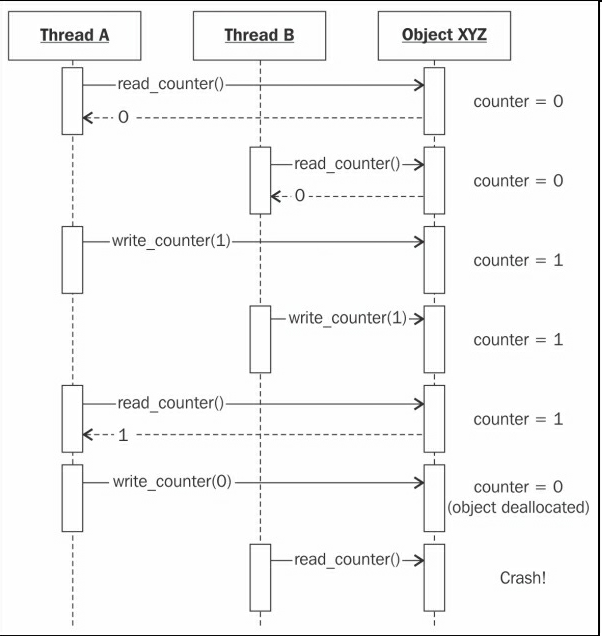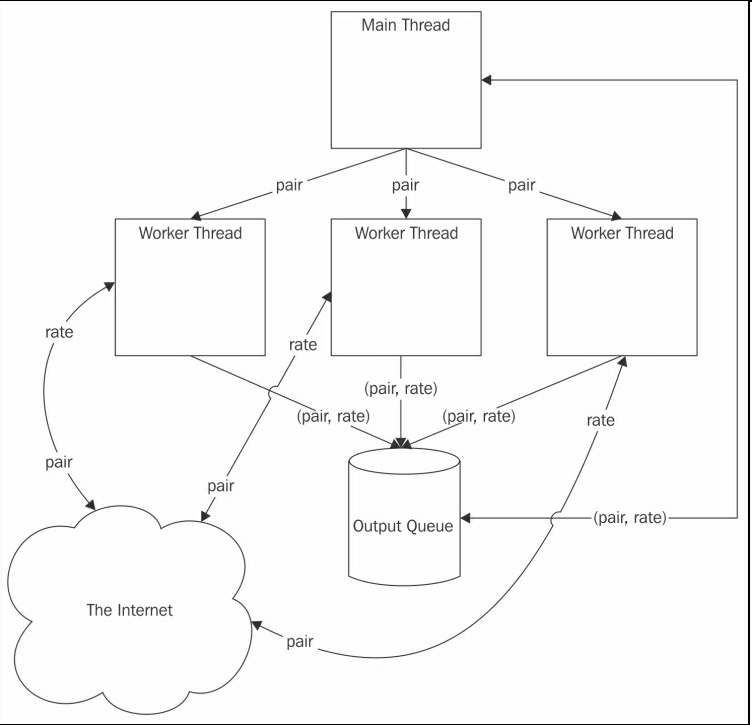序言
第1章 并行和分布式计算介绍
第2章 异步编程
第3章 Python的并行计算
第4章 Celery分布式应用
第5章 云平台部署Python
第6章 超级计算机群使用Python
第7章 测试和调试分布式应用
第8章 继续学习
我们在前两章提到了线程、进程,还有并发编程。我们在很高的层次,用抽象的名词,讲了如何组织代码,已让其部分并发运行,在多个CPU上或在多台机器上。
本章中,我们会更细致的学习Python是如何使用多个CPU进行并发编程的。具体目标是加速CPU密集型任务,提高I/O密集型任务的反馈性。
好消息是,使用Python的标准库就可以进行并发编程。这不是说不用第三方的库或工具。只是本章中的代码仅仅利用到了Python的标准库。
本章介绍如下内容:
- 多线程
- 多进程
- 多进程队列
多线程
Python从1.4版本开始就支持多线程了。它在threading模块中还提供了一个高级界面给系统本地(Linux和Mac OS X中的POSIX)线程,本章的例子会使用threading。
要注意在单CPU系统中,使用多线程并不是真正的并发,在给定时间只有一个线程在运行。只有在多CPU计算机上,线程才是并发的。本章假设使用的计算机是多处理器的。
让我们写一个简单的例子,使用多线程从网络下载数据。使用你的编辑器,新建一个Python文件,currency.py,代码如下:
from threading import Thread
from queue import Queue
import urllib.request
URL = 'http://finance.yahoo.com/d/quotes.csv?s={}=X&f=p'
def get_rate(pair, outq, url_tmplt=URL):
with urllib.request.urlopen(url_tmplt.format(pair)) as res:
body = res.read()
outq.put((pair, float(body.strip())))
if __name__ == '__main__':
import argparse
parser = argparse.ArgumentParser()
parser.add_argument('pairs', type=str, nargs='+')
args = parser.parse_args()
outputq = Queue()
for pair in args.pairs:
t = Thread(target=get_rate,
kwargs={'pair': pair,
'outq': outputq})
t.daemon = True
t.start()
for _ in args.pairs:
pair, rate = outputq.get()
print(pair, rate)
outputq.task_done()
outputq.join()
这段代码十分简单。我们先从标准库引入需要的模块(threading、queue、urllib.request)。然后定义一个简单的函数get_rate,用以得到货币对(即EURUSD代表欧元兑美元,CHFAUS代表瑞士法郎兑澳元),和一个线程安全型队列(即,一个Python的queue模块Queue实例),用以链接Yahoo!Finance,并下载最新的汇率。
调用Yahoo!Finance API会返回包括数字的白文本(或者一个包含信息的CSV文件)。这意味着,我们不必解析HTML,直接可以在文本中找到需要的汇率。
此段代码使用了argparse模块,解析命令行参数。然后构造了一个队列(outputq),来保存各个线程下载的汇率的数据。一旦有了输出队列,我们就可以为每个汇率对新建一个工作线程。每个线程运行get_rate函数,使用汇率对和输出队列作为参数。
因为这些线程只是fire和forget线程,可以将它们做成守护进程,也就是说,Python主程序退出时不会等待它们退出(进程术语join)。
正确理解最后的守护进程和队列是十分重要的。使用线程的最大难点是,我们无法判断某个线程何时进行读取或写入与其它线程共享的数据。
这就会造成所谓的竞争条件。一方面,系统的正确执行取决于某些动作按顺序执行;另一方面,不能保证这些动作按照这些动作按照设计的顺序执行。
竞争条件的一个简单例子是引用计数算法。引用计数中,垃圾回收解释器如CPython(Python的标准解释器),每个对象都有一个计数器,用于跟踪引用的次数。
每一次引用一个对象时,对应的计数器增加1。每一次删除一个引用时,计数器减1。当计数器为0时,对象就被删除了。尝试使用被删除的对象,会发生语法错误。
这意味着,我们必须强制给计数器的增加和减少添加一个顺序。设想两个线程获取一个对象的引用一段时间,然后删除。如果两个线程在同一时间访问同一个引用计数器,它们就会复写值,如下图所示:

解决此类同步问题的方法之一是使用锁。线程安全队列是一个简易的使用锁数据结构的例子,使用它可以组织数据的访问。
因为每个线程都向同一个输出队列写入,我们最好监督队列,好知道何时有了结果,进而退出。在前面的代码中,我们的实现方法是从每个汇率对的队列取出一个结果(args.pairs循环),等待队列来加入(outputq。join()),即取得多有数据之后(更准确的,当每个get()方法之后都调用task_done())。这样,就可以保证程序不提前退出。
尽管这个代码只是示例,没有进行查错、重试、处理缺省值或无效数值,它仍然是一个有用的、以队列为基础的架构。但是,要记住,使用锁的队列控制数据访问、避免竞争条件,取决于应用,可能花费很高。
下图展示了这个例子的架构,有三个工作线程,用以获取三个汇率值的数据,并将名字和数值存储到输出队列:

当然,我们可以不用线程,依次调用get_rate()函数取得每个汇率值。打开Python shell,我们可以如下实现:
>>> from currency import get_rate
>>> import queue
>>> from time import time
>>> q = queue.Queue()
>>> pairs = ('EURUSD', 'GBPUSD', 'CHFEUR')
>>> t0 = time(); [get_rate(p, q) for p in pairs]; dt = time() - t0
[None, None, None]
>>> dt
1.1785249710083008
>>> [q.get() for p in pairs]
[('EURUSD', 1.1042), ('GBPUSD', 1.5309), ('CHFEUR', 0.9176)]
每次使用一个请求,取得三个汇率,耗时1.2秒。
让我们运行下使用线程的例子:
$ time python3.5 currency.py EURUSD GBPUSD CHFEUR
EURUSD 1.1042
GBPUSD 1.5309
CHFEUR 0.9176
python3.5 currency.py EURUSD GBPUSD CHFEUR 0.08s user 0.02s system 26% cpu 0.380 total
后者总耗时0.4秒,为什么它的速度是前者的三倍呢?原因是,使用线程,可以并行运行三个请求。当然,还有一个主线程和队列(根据阿姆达尔定律,它们都属于序列分量),但是通过并发,还是使性能得到了极大提高。另外,我们可以像上一章一样,在单CPU上使用协程和非阻塞socket。
让我们看另一个例子,虽然使用了线程,性能却没有提高。用下面的代码新建一个文件(fib.py):
from threading import Thread
def fib(n):
if n <= 2:
return 1
elif n == 0:
return 0
elif n < 0:
raise Exception('fib(n) is undefined for n < 0')
return fib(n - 1) + fib(n - 2)
if __name__ == '__main__':
import argparse
parser = argparse.ArgumentParser()
parser.add_argument('-n', type=int, default=1)
parser.add_argument('number', type=int, nargs='?', default=34)
args = parser.parse_args()
assert args.n >= 1, 'The number of threads has to be > 1'
for i in range(args.n):
t = Thread(target=fib, args=(args.number,))
t.start()
这段代码很好理解。先引入线程模块,然后让每个线程计算斐波那契额数args.number。我们并不关心斐波那契额数(不进行存储),只是想进行一些CPU密集型计算,计算菲波那切数列是一个很好的例子。
用不同并发程度,运行这个例子,如下所示:
$ time python3.5 ./fib.py -n 1 34
python3.5 ./fib.py -n 1 34 2.00s user 0.01s system 99% cpu 2.013 total
$ time python3.5 ./fib.py -n 2 34
python3.5 ./fib.py -n 2 34 4.38s user 0.04s system 100% cpu 4.414 total
$ time python3.5 ./fib.py -n 3 34
python3.5 ./fib.py -n 3 34 6.28s user 0.08s system 100% cpu 6.354 total
$ time python3.5 ./fib.py -n 4 34
python3.5 ./fib.py -n 4 34 8.47s user 0.11s yousystem 100% cpu 8.541 total
有趣的是,当用两个线程计算前34个斐波那契数时,耗时是单线程的两倍。增加线程的数目,会线性的增加耗时。很明显,并行运行的线程发生了错误。
Python底层有个东西影响着我们的CPU制约型进程,它就是全局锁(Global Interpreter Lock)。正如它的名字,全局锁控制引用计数始终合理。尽管Python的线程是OS原生的,全局锁却使特定时间只有一个是运行的。
有人会说Python是单线程的,这并不正确。但也不全部错误。刚刚我们看到的,和之前的协程很像。在协程的例子中,在给定时间只有一段代码才能运行,当一个协程或进程等待I/O时,让另一个运行CPU,也可以达到并发的效果。当一个任务需要占用CPU大量时间时,就像菲波那切数列这个CPU制约型任务,就不会有多大提高。
与协程很像,在Python中使用线程是可取的。并行I/O可以极大提高性能,无论是对多线程还是协程。GUI应用也可以从使用线程受益,一个线程可以处理更新GUI,另一个在后台运行,而不必使前台死机。只需要注意全局锁,做好应对。另外,并不是所有Python解释器都有全局锁,Jython就没有。
多进程
传统上,Python开发者为了避免全局锁对CPU制约型线程的影响,使用的是多进程而不是多线程。多进程有一些缺点,它必须启动Python的多个实例,启动时间长,耗费内存多。
同时,使用多进程并行运行任务,有一些极好的优点。
多进程有它们各自的内存空间,使用的是无共享架构,数据访问十分清晰。也更容易移植到分布式系统中。
Python的标准库中有两个模块,可以用来实现并行进程,两个模块都很优秀。其中之一是multiprocessing,另一个是concurrent.futures。concurrent.futures模块构建在multiprocessing和threading模块之上,提供更优的功能。
我们在下一个例子中使用的是concurrent.futures。Python 2.x用户可以用外部包的方式安装,即futures。
我们还是使用之前的菲波那切数列例子,这次使用多进程。同时,会快速介绍concurrent.futures模块。
使用下面代码新建一个文件(mpfib.py):
import concurrent.futures as cf
def fib(n):
if n <= 2:
return 1
elif n == 0:
return 0
elif n < 0:
raise Exception('fib(n) is undefined for n < 0')
return fib(n - 1) + fib(n - 2)
if __name__ == '__main__':
import argparse
parser = argparse.ArgumentParser()
parser.add_argument('-n', type=int, default=1)
parser.add_argument('number', type=int, nargs='?', default=34)
args = parser.parse_args()
assert args.n >= 1, 'The number of threads has to be > 1'
with cf.ProcessPoolExecutor(max_workers=args.n) as pool:
results = pool.map(fib, [args.number] * args.n)
这段代码很紧凑,也很易读。看一下它与多线程的不同,我们得到命令行参数之后,创建了一个ProcessPoolExecutor实例,调用它的map()方法进行并行计算。
根据直觉,我们建立了一个工作进程池args.n,使用这个进程池对每个输入(args.number重复args.n次)执行fib函数,以并行方式运行(取决于CPU的数目)。
(在一个四处理器的计算机上)运行这段代码,结果如下:
$ time python3.5 ./mpfib.py -n 1 34
python3.5 ./mpfib.py -n 1 34 1.89s user 0.02s system 99% cpu 1.910 total
$ time python3.5 ./mpfib.py -n 2 34
python3.5 ./mpfib.py -n 2 34 3.76s user 0.02s system 196% cpu 1.928 total
$ time python3.5 ./mpfib.py -n 3 34
python3.5 ./mpfib.py -n 3 34 5.70s user 0.03s system 291% cpu 1.964 total
$ time python3.5 ./mpfib.py -n 4 34
python3.5 ./mpfib.py -n 4 34 7.71s user 0.03s system 386% cpu 2.006 total
我们看到,在四处理器的计算机上运行时,可以实现真正的并行,运行一次到四次,时间差不多。
进程数比处理器数目多时,性能会急剧下降,如下所示:
$ time python3.5 ./mpfib.py -n 8 34
python3.5 ./mpfib.py -n 8 34 30.23s user 0.06s system 755% cpu 4.011 total
$ time python3.5 ./mpfib.py -n 16 34
python3.5 ./mpfib.py -n 16 34 63.78s user 0.13s system 758% cpu 8.424 total
再看一下代码的最后两行,这里的内容不少。首先,使用concurrent.futures模块导出的ProcessPoolExecutor类。它是被导出的两个类之一,另一个是ThreadPoolExecutor,用它来建立线程池,而不是进程池。
ProcessPoolExecutor和ThreadPoolExecutor有相同的API(实际上,二者都是同一个类的子类),它们有三个主要方法,如下:
-
submit(f, *args, **kwargs):用来规划异步调用f(*args, **kwargs),并返回一个Future实例作为结果占位符。 -
map(f, *arglist, timeout=None, chunksize=1):它等价于内建的(f, *arglist)方法,它返回的是一个列表的Future对象,而不是map那样的结果。
第三种方法shutdown(wait=True)用来当所有Executor对象运行完毕时,释放资源。之前,则一直在等待(if wait=True)。运行这个方法之后再使用Executor对象,会抛出RuntimeError异常。
Executor对象还可以用来当做上下文管理(context manager),正如例子中,使用cf.ProcessPoolExecutor(max_workers=args.n)构建pool。上下文管理退出时,会默认阻塞调用Executor shutdown方法。这意味着,一旦上下文管理退出,我们访问results列表只会得到一些整数而不是Future实例。
Future实例是concurrent.futures包导出的另一个主要的类,它是异步调用的结果占位符。我们可以用它检测是否调用仍在运行,是否抛出异常,等等。我们调用一个Future实例的result()方法,来访问它的值。
不用上下文管理,再来运行一下这个例子。这样,就可以观察运行的Future类。结果如下:
>>> from mpfib import fib
>>> from concurrent.futures import ProcessPoolExecutor
>>> pool = ProcessPoolExecutor(max_workers=1)
>>> fut = pool.submit(fib, 38)
>>> fut
<Future at 0x101b74128 state=running>
>>> fut.running()
True
>>> fut.done()
False
>>> fut.result(timeout=0)
Traceback (most recent call last):
File "<stdin>", line 1, in <module>
File "/Library/Frameworks/Python.framework/Versions/3.5/lib/python3.5/concurrent/futures/_base.py", line 407, in result
raise TimeoutError()
concurrent.futures._base.TimeoutError
>>> fut.result(timeout=None)
39088169
>>> fut
<Future at 0x101b74128 state=finished returned int>
>>> fut.done()
True
>>> fut.running()
False
>>> fut.cancelled()
False
>>> fut.exception()
这里,我们看到如何使用concurrent.futures包创建工作池(使用ProcessPoolExecutor类),并给它分配工作(pool.submit(fib, 38))。正如所料,submit返回了一个Future对象(代码中的fut),它是还没产生结果时的占位符。
我们检测fut以确认它的状态,运行(fut.running()),完毕(fut.done()),取消(fut.cancelled())。如果没有产生结果(fut.result(timeout=0)),就检测,会抛出异常TimeoutError。意味着,我们必须要么等待Future对象可用,或不设置超时的情况下,询问它的值。这就是我们做的,fut.result(timeout=None),它会一直等待Future对象。因为代码没有错误,fut.exception()返回的是None。
我们可以只修改一行多进程的例子代码,就将它编程多线程的,将ProcessPoolExecutor换成ThreadPoolExecutor。快速写一个例子,将之前的例子(mpfib.py),更换下行:
with cf. ProcessPoolExecutor (max_workers=args.n) as pool:
为:
with cf.ThreadPoolExecutor(max_workers=args.n) as pool:
新文件(mtfib.py)的性能和之前的fib.py的性能差不多,如下所示:
$ time python3.5 ./mtfib.py -n 1 34
python3.5 ./mtfib.py -n 1 34 2.04s user 0.01s system 99% cpu 2.059 total
$ time python3.5 ./mtfib.py -n 2 34
python3.5 ./mtfib.py -n 2 34 4.43s user 0.04s system 100% cpu 4.467 total
$ time python3.5 ./mtfib.py -n 3 34
python3.5 ./mtfib.py -n 3 34 6.69s user 0.06s system 100% cpu 6.720 total
$ time python3.5 ./mtfib.py -n 4 34
python3.5 ./mtfib.py -n 4 34 8.98s user 0.10s system 100% cpu 9.022 total
多进程队列
多进程要解决的问题是,如何在工作进程之间交换数据。multiprocessing模块提供的方法是队列和管道。接下来,我们来看多进程队列。
multiprocessing.Queue 类是按照queue.Queue类建模的,不同之处是多进程队列中的items要求是可选取的。为了展示如何使用队列,新建一个文件(queues.py),它的代码如下:
import multiprocessing as mp
def fib(n):
if n <= 2:
return 1
elif n == 0:
return 0
elif n < 0:
raise Exception('fib(n) is undefined for n < 0')
return fib(n - 1) + fib(n - 2)
def worker(inq, outq):
while True:
data = inq.get()
if data is None:
return
fn, arg = data
outq.put(fn(arg))
if __name__ == '__main__':
import argparse
parser = argparse.ArgumentParser()
parser.add_argument('-n', type=int, default=1)
parser.add_argument('number', type=int, nargs='?', default=34)
args = parser.parse_args()
assert args.n >= 1, 'The number of threads has to be > 1'
tasks = mp.Queue()
results = mp.Queue()
for i in range(args.n):
tasks.put((fib, args.number))
for i in range(args.n):
mp.Process(target=worker, args=(tasks, results)).start()
for i in range(args.n):
print(results.get())
for i in range(args.n):
tasks.put(None)
到这里,你应该对代码很熟悉了。我们还是用递归方法计算计算菲波那切数列。我们使用两个队列的架构,一个队列运行任务(调用函数和参数),另一个队列保存结果(整数)。
在任务队列中使用一个哨兵值(None),给工作进程发消息,好让其退出。工作进程是一个简单的multiprocessing.Process实例,它的目标是worker函数。
这个队列的例子的性能和无队列例子(mpfib.py)的性能相同,如下所示:
$ time python3.5 ./queues.py -n 1 34
5702887
python3.5 ./queues.py -n 1 34 1.87s user 0.02s system 99% cpu 1.890 total
$ time python3.5 ./queues.py -n 4 34
5702887 (repeated 4 times)
python3.5 ./queues.py -n 4 34 7.66s user 0.03s system 383% cpu 2.005 total
$ time python3.5 ./queues.py -n 8 34
5702887 (repeated 8 times)
python3.5 ./queues.py -n 8 34 30.46s user 0.06s system 762% cpu 4.003 total
对于我们的例子,添加几个队列不会产生明显的性能下降。
一些思考
开发并行应用的主要难点就是控制数据访问,避免竞争条件或篡改共享数据。有时,发生异常很容易发现错误。其他时候,就不容易发现,程序持续运行,但结果都是错的。
检测程序和内部函数是很重要的。对于并行应用,检测更为重要,因为想要建立一个逻辑图十分困难。
并行开发的另一难点是,要明确何时停止。阿姆达尔定律指出,并行开发是收益递减的。并行化可能耗时巨大。一定要知道,哪段代码是需要并行化的,理论加速上限又是多少。
只有这样,我们才能知道何时该停止继续投入。其它时候,使用现存的并行库(如Numpy),可以提供更好的收益。
另外,避免收益递减的方法是增加任务量,因为计算机的性能是不断提高的。
当然,随着任务量增大,创建、协调、清洗的贡献就变小了。这是古斯塔夫森定律的核心。
总结
我们学习了一些可以让Python加速运行或是在多个CPU上运行的方法。其一是使用多线程,另一个是多进程。这两个都是Python的标准库支持的。
我们学习了三个模块:开发多线程应用的threading,开发并行多进程的multiprocessing,还有更高级的异步模块concurrent.futures。
随着技术的发展,Python中开发并行应用不仅只有这三个模块。其它的包封装了并行策略,可以解放开发者。可能,最有名的就是NumPy,Python处理array和matrix标准包。依赖BLAS库,NumPy可以用多线程加速运行复杂运算(比如矩阵的点乘)。
multiprocessing模块可以让Python运行在计算机集群上。特别的,它有几个Manager类(即BaseManager和SyncManager)。它使用socket服务器管理数据和队列,并在网络中共享。感兴趣的读者可以继续阅读多进程模块的文档https://docs.python.org/3/library/multiprocessing.html#managers。
另一个值得关注的是Cython,一个类似Python的原因,它可以建立C模块,现在非常流行。Cython对OpenMP(一个基于指令的C、C++、Fortran的API)支持很好,可以让开发者方便地使用多线程。
序言
第1章 并行和分布式计算介绍
第2章 异步编程
第3章 Python的并行计算
第4章 Celery分布式应用
第5章 云平台部署Python
第6章 超级计算机群使用Python
第7章 测试和调试分布式应用
第8章 继续学习





















 1008
1008

 被折叠的 条评论
为什么被折叠?
被折叠的 条评论
为什么被折叠?








